Diamond
As the saying goes A \"Diamond is Forever\"...so if you value your Diamond then it is imperative to know about this precious, desirable, sparkling token of love.

Historical and Cultural Significance : \'Diamond\' derives its name from the Greek word \"adamas,\" meaning unconquerable.
The Romans thought diamonds were splinters from falling stars and valued the diamond entirely on account of the stone\'s supernatural powers. Pliny wrote that a Diamond baffles poison, keeps off insanity, and dispels vain fears. The Greeks regarded the sparkling gems as tears of the Gods.



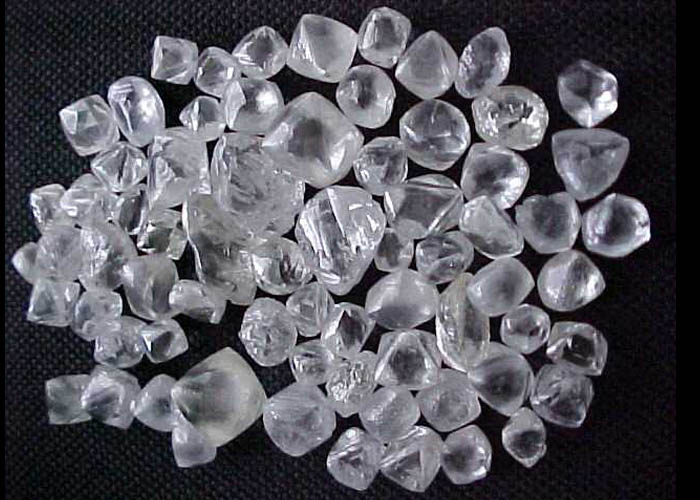
In 1477, an Austrian Archduke Maximilian placed the first diamond engagement ring on the fourth finger of his betrothed, Mary of Burgundy's left hand, because that finger was believed to course with the vein of love that passed directly to the heart. The medieval Italians called a Diamond the "Pietra della Reconciliazione" (stone of reconciliation) because it maintained concord between husband and wife. Five centuries later, the diamond remains one of the most luxurious and desirable token's of adoration for any romantic and celebratory occasion, whose purity and brilliance symbolizes lasting love.
The diamond, classified as a 'Hot Gem' is the birthstone for people born in the month of April and represents the planet Venus and normally worn on the middle finger set in Gold. It is also used as the symbol of a sixty-year anniversary, such as a Diamond Jubilee. It was used to represent the color sable, or black in the past for the arms of nobles.
According to Vedic Astrology, a Diamond represents luxury and worn to enhance the name, fame and artistic quality of a person. It also enhances sexual power, cures diabetes, urinary and venereal diseases, skin and uterine diseases. In Hinduism, God Indra uses Vajrayudham or the thunderbolt as his primary weapon. Vajra is the word for diamond and ayudham means weapon in Sansktrit. Another name for it was Agira which means fire or the sun. In fact there are 14 names counted to be given to a diamond in traditional Hinduism.
Diamond Cut Guide
Different Shapes Of A Diamond - A Cutter’s Labour Of Love
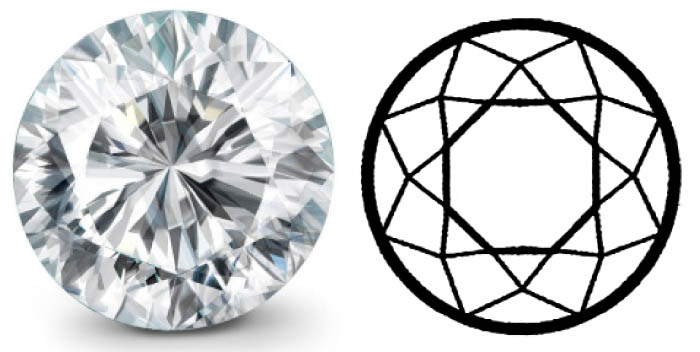
Round Brilliant : This cut has set the traditional standard for all shapes and 75% of the diamonds sold today are Round Brilliant, mostly in the form of rings. Its 58-facet cut, divided among its crown (top), girdle (widest part) and pavilion (base), is a challenge for all Diamond Cutters and calibrated through a precise formula to achieve the maximum in brilliance.
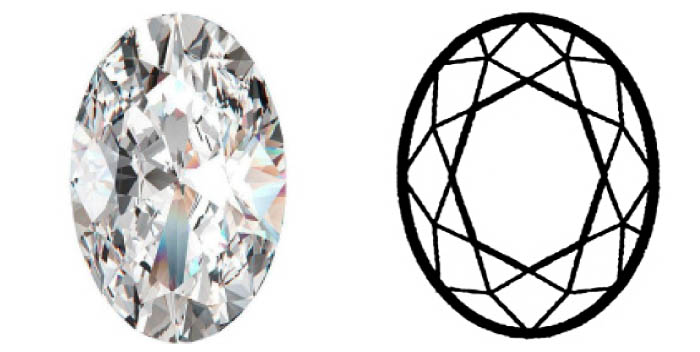
Oval : This is an even symmetrical design that appeals to many small handed women seemingly with elongated hands and fingers.
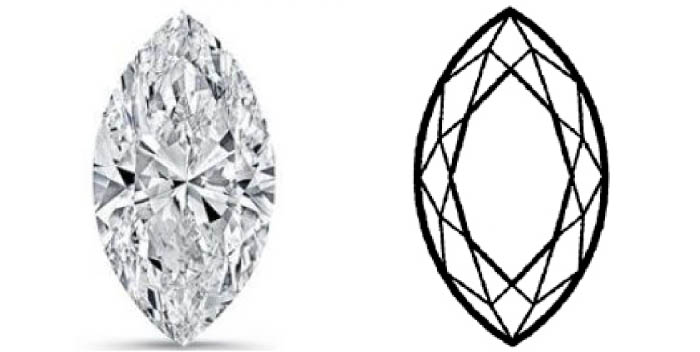
Marquise : This shape is elongated with pointed ends. The smile of the Marquise de Pompadour inspired this shape which was then commissioned by then France's King Louis XIV, who wanted a diamond to match it. It is beautiful as a solitaire and when matched with small complimentary diamonds.
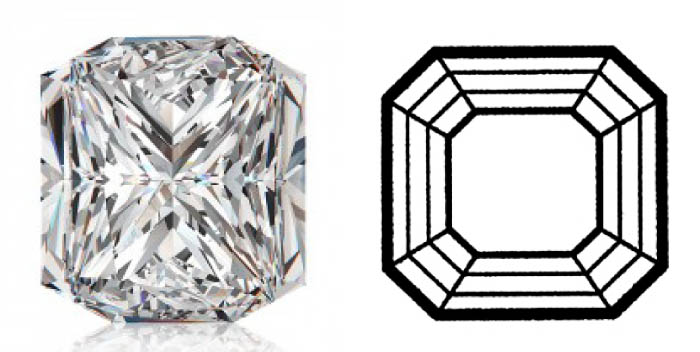
Radiant : This is a square or rectangular shape. The elegance and the brilliance of the round shape mark this cut. Nearly 70 facets maximize the effect of its colour refraction.

Heart : A pear shaped diamond with a cleft on the top. The extraordinary skill of the cutter determines the beauty of this cut.

Emerald : This rectangular shape with cut corner's is known as a step cut because of its concentric broad, flat planes that resemble a staircase. Clarity and colour should be looked at carefully when a choice is made if inclusions and inferior colour are more pronounced in this particular cut.
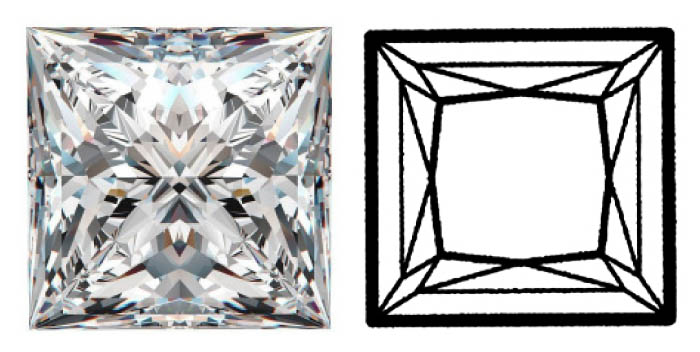
Princess : This is a relatively new cut, either square or rectangular in shape with many facets. It is used for solitaire engagement rings. This cut requires more weight to be directed toward the diamond's depth in order to maximize brilliance. It suits long fingers.
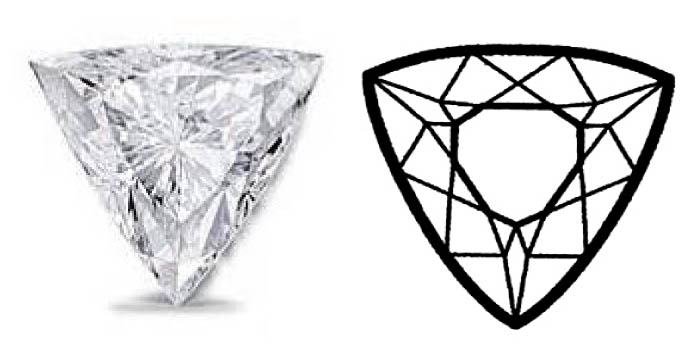
Trillion : This is the spectacular wedge shape first designed in Amsterdam. This design can vary depending on a diamond's natural features and the diamond cutter's personal preferences. The shape looks like a traditional triangle with pointed corners, though more rounded shapes can be found.

Pear : This cut is a hybrid of the Oval and Marquise shapes and looks like a sparkling teardrop. It compliment's the average sized hand and fingers. It is also gorgeous for pendants and earrings.

Cushion Cut : A late 19th and early 20th style antique type shape having a deep cut with large facets.
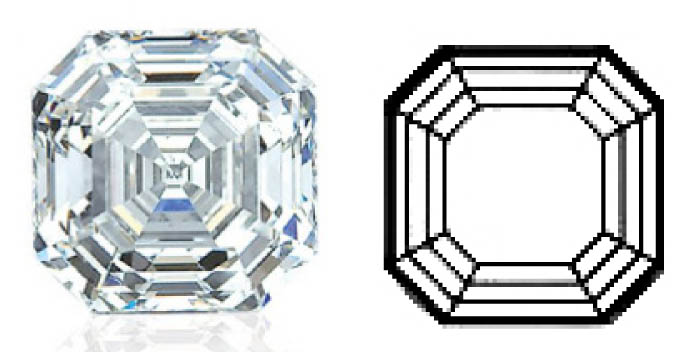
Asscher Cut : This cut was popularised in the 1920's by the Asscher Diamond Company in Amsterdam having an art deco feeling which was very popular at the time. During the Depression the company went out of business and Asscher cuts disappeared from the market. However this shape has come back into style now.
Characteristics of The Diamond
Diamonds are a crystallized form of carbon formed nearly 100 million years ago and brought to the Earth's surface by volcanic eruptions. The gemstone is tough, hard and durable. It has a very high degree of transparency, refractivity and dispersion or 'fire' which gives rise to sheer brilliancy and a display of prismatic colours in cut diamonds. The gemstone is endowed with a rare beauty where each stone's complex characteristics cannot be duplicated, and no two diamonds can ever be the same. Its durability makes it resistant to deterioration. If cared for properly, diamond jewellery can be worn every day and passed on as an heirloom to the next generation. It's rare, as more than 250 tons of ore needs to be blasted, crushed and processed to yield just one carat of rough diamond. Further, only 20% of all rough diamonds are suitable for gem cutting. Finally it's enduring value, though diamond prices fluctuate yet these sparkling gemstones retain their value after years of being worn and enjoyed. Today the same features can be emulated by laboratory created diamonds which have the durability and lustre of naturally occurring diamonds and retain their value forever.
Many synthetic materials are also made to closely resemble diamond, such as YAG (Yttrium Aluminum Garnet), Strontium Titanate, Moissanite, and Cubic Zirconia, which is a Diamond's main imposter. However, Diamond is distinguished from all the others by its immense hardness.
Choosing A Diamond?
The 4 C's - Cut, Colour, Clarity & Carat
1. Diamond Cut
It is the work of a master cutter that allows the diamond to be cut in such a way as to permit the maximum amount of light to be reflected through the diamond. Most diamonds are cut round with full 58 facets and it is the cut that enables a diamond to make the best use of light. This is commonly misunderstood as the shape of the diamond. However a cut is measured on quality based on the difference between the thickest and thinnest points on a scale including excellent, very good, good, fair and poor. A diamond's cut can be broken down into two sub-grades: Polish and Symmetry assigned with their own grading that makes the total cut grade. The polish refers to the surface quality while the symmetry refers to the exactness of the diamond's shape considering the arrangement of the facets.

2. Diamond Carat Size
A carat is a weight measuring unit equal to 0.2 grams. It is the internationally used unit to measure the weight of diamonds. Within the diamond trade, fractions of a carat are referred to as "points" or simply as fractions. A 50-point diamond weighs 0.5 carats or 1/2 a carat. A 1-carat diamond weighs 100 points. Rough, uncut diamonds come in all shapes and sizes, as well as colours and purity. The larger, whiter and cleaner the diamond, the more rare it is. Accordingly, the cost per carat of a larger diamond of the same colour, clarity and cut will be higher than a smaller diamond. The price per carat of diamonds rises proportionately with size. The carat price gets multiplied by the carat weight. More weight equals more money hence many diamond cutters sacrifice brilliance to maximize carat weight and profit. It is important to realize that weight does not always equal size or beauty. Poorly cut diamonds intended to maximize size can be dull and lifeless.

3. Diamond Colour Grading Scale
Most diamonds have a slight hint of yellow and the diamond colour scale is based on the amount of yellow present in a diamond. The colourless stone is most often used for jewellery, although yellows and browns are also used. The Brown stones are often marketed as "chocolate", "cognac", or "champagne" Other fancies are too rare and expensive for the mainstream jewellery industry, and are exclusively reserved for the high end consumer. Black, opaque Diamonds are occasionally faceted into black gemstones with a submetallic lustre. Other varieties include: Bort; A Dark coloured, imperfectly crystallized, opaque Diamond, Canary Diamond; A Diamond with a deep yellow colour and Fancy; Refers to rarely coloured and well sought after Diamonds such as blue, red, pink, purple, green, dark yellow and dark brown colours.
The colour is graded according to the Gemological Institute of America (GIA) Grading Scale. Grades are based on the amount of yellow that is visible when viewed facedown through the pavilion on a white diamond colour card using daylight equivalent to fluorescent light. Each colour grade is based on a very small range. Colour grades sit on a scale from D-Z with D being completely void of colour and very valuable and considered the whitest diamond available. This is also the rarest colour grade, which translates to a higher value. The highest colour grade Colours E and F have no detectable colour to the naked eye and they fall into the Colourless category. Diamonds in the G to J colour range have a hint of colour and are considered Near Colourless. The eye begins to detect faint traces of yellow in diamonds that are in the J to M range. An ideal diamond typically sells in the colour range of D to J and occasionally K. The Z grade has a yellow tone, making it less desirable. When a diamond is colour graded it is compared using a set of master gemstones. These gemstones are a set of real diamonds that display a range of known colours. It is extremely difficult to see the colour differences within diamonds, but the master gemstones help graders distinguish between one colour and the next.
The American Gem Society (AGS) uses a slightly different colour grading scale. It ranks the stones from 0-10, in 0.5 increments with 0 representing the equivalent of colourless D stones, and 10 representing the equivalent of X, Y and Z coloured diamonds.
Fluorescence is a reaction of trace minerals that causes a "glowing" effect under ultraviolet light. Approximately one-third of diamonds are fluorescent, and while it's not universal, fluorescence can change the perceived appearance of real colour, depending on its strength. Fluorescence used to be considered wholly negative to a diamond's value, but modern understanding has proven that fluorescence can both positively and negatively impact a diamond's value.

4. Diamond Clarity Grading Scale
A diamond's clarity is a description of its internal purity and not easy to determine with the naked eye. The clarity scale was developed by the Gemological Institute of America (GIA) to quantify these imperfections. The American Gem Society (AGS) uses the same standards as the GIA; however, the AGS uses a numerical system where "0" is the cleanest (GIA "IF") and "10" is the most imperfect (GIA "I3"). All diamonds are systematically graded and plotted under 10X magnification. If a trained grader cannot see a clarity characteristic at 10X, it does not affect the clarity grade. When an appraiser examines a diamond, they must use special tools to see blemishes and inclusions (internal flaws). A diamond that is graded "internally flawless (IF)" without any blemishes or inclusions is very rare and valuable. The other end of the scale is "I1" meaning that inclusions can be seen with the naked eye.

Certified Gemological Laboratories
in Order of Reliability to Choose Diamonds: The fifth 'C'
1. GIA : Gemological Institute of America
2. HRD : Hoge Raad voor Diamant (Belgium)
3. AGS : American Gem Society
4. IGI : International Gemological Institute
The four main grading laboratories used by the diamond industry vary in terms of their consistency, reliability and added market value.

With the growing importance of a reputed laboratory report, the practice of inscription has grown as well. It includes etching of the grading report number associated with the stone. This is to assure that jewelers, resellers, or handlers do not 'switch' out the stone for one of a lesser quality. It also helps to investigate diamonds that may have been stolen and recovered. Plotting used to be the most common way to etch a diamond's value onto it however this method was found to affect the clarity of the stone. Since then, Laser Inscriptions have become the new standard as they have almost no adverse effect on the quality of the stone. As buyers are becoming aware, requests for laser inscriptions are going up amongst diamond jewelers. Buy a significantly sized diamond which is accompanied by an independent diamond certificate. This helps to ensure that the diamond is of the quality and size that you paid for. A Diamond Certificate will explain in detail the characteristics of your diamond. This will include the diamond carat size, diamond cut, diamond clarity and diamond colour.